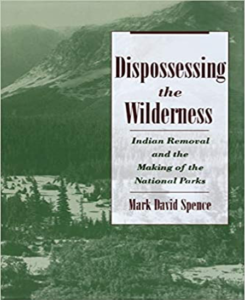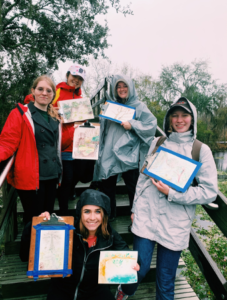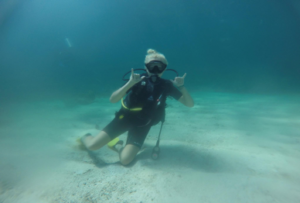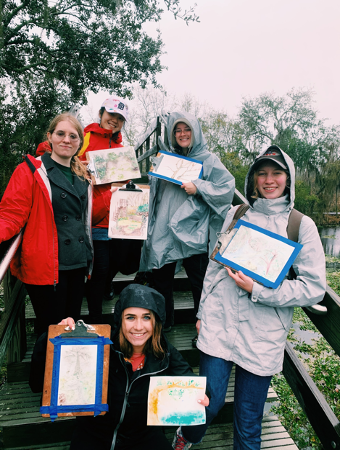Walking on Indigenous Lands – The importance of learning the history behind your favorite outdoor areas
By Amelia Eldridge
One of my favorite trips I have ever led as an Outdoor Adventure Leader at Tulane has been ‘Watercolors on the Bayou’ – an amazing day trip of painting watercolors and hiking around Barataria Preserve. Though I could tell you the names of many of the plants and animals we encounter while walking in the bayou that day, I have only begun to think about how I know so little about how the park actually came to be and the people who have inhabited this land throughout time.
 With all that is going on right now with Black Lives Matter and while educating myself on the inequalities that exist without the Outdoors community, I have realized that one of the most important aspects that has been missing from my outdoor life and education is the need to fully educate myself about the history of the places I am going to explore. I believe that people who visit outdoor areas (myself included) do not often think of the places they are passing through in the context of who has inhabited them before, but I have learned that it is crucial to recognize that so many of our national parks and lands are deeply intertwined with Indigenous communities across the country. These primary inhabitants have protected and sustained the biodiversity and conservation of so much of what is now our national parks and protected areas, yet have faced relocations, land-theft, and even genocides over the lands that we now see as ‘havens’.
With all that is going on right now with Black Lives Matter and while educating myself on the inequalities that exist without the Outdoors community, I have realized that one of the most important aspects that has been missing from my outdoor life and education is the need to fully educate myself about the history of the places I am going to explore. I believe that people who visit outdoor areas (myself included) do not often think of the places they are passing through in the context of who has inhabited them before, but I have learned that it is crucial to recognize that so many of our national parks and lands are deeply intertwined with Indigenous communities across the country. These primary inhabitants have protected and sustained the biodiversity and conservation of so much of what is now our national parks and protected areas, yet have faced relocations, land-theft, and even genocides over the lands that we now see as ‘havens’.
Having learned this extremely important, yet often overlooked, aspect of the outdoors, I am making it a mission for me – and my Outdoor Adventure peers – to fully educate ourselves about the history of the land on which we lead trips. This is just a small way that we can begin to intertwine our organization and actions with movements that aim to ensure the outdoors are available and equalizing for everyone. We will then be able to share these histories with our participants – giving them not only a fun outdoors outing, but a valuable and enriching education experience based on the lands beneath their very feet.
For example, here is a taste of the history you would learn if you join us for the  Watercolors on the Bayou trip!: Barataria Preserve is one of the six sites composing the Jean Lafitte National Historical Park and Preserve here in Louisiana. This collection of parks and lands in the Mississippi Delta region are thought to have been first inhabited some 2,500 year ago by Indignous tribes such as Chitimacha and Houma. These groups had both permanent settlements as well as seasonal camps, and evidence of their ways of life can still be seen – for example along the Bayou Coquille Trail which starts at the site of “a pre-contact American Indian village”. Researchers have even found and dated shell mounds, middens, and burial sites along this route that date back to these early inhabitant days. Pretty cool huh! Come join us to learn some more 🙂
Watercolors on the Bayou trip!: Barataria Preserve is one of the six sites composing the Jean Lafitte National Historical Park and Preserve here in Louisiana. This collection of parks and lands in the Mississippi Delta region are thought to have been first inhabited some 2,500 year ago by Indignous tribes such as Chitimacha and Houma. These groups had both permanent settlements as well as seasonal camps, and evidence of their ways of life can still be seen – for example along the Bayou Coquille Trail which starts at the site of “a pre-contact American Indian village”. Researchers have even found and dated shell mounds, middens, and burial sites along this route that date back to these early inhabitant days. Pretty cool huh! Come join us to learn some more 🙂
Other great articles, books, and resources about this topic:
- Native-land.ca – map that shows the Indigenous populations and territories
- Whose Land’ – App that works to identify Indigenous Nations, territories, and Indigenous communities
- History & Culture of Jean Lafitte
Author Biography
Name: Amelia Eldridge
Year in School: Senior
Major: Neuroscience + Public Health
Hometown: Oakland, CA
Favorite Outdoor Activity: Anything in the water or in the mountains!
Favorite Camp Food: Trail Mix
Ideal Outdoor Trip Destination: Koroyanitu National Park, Fiji
If you were stranded on a desert island, what/who would you bring with you: Bear Grylls and some chex mix
